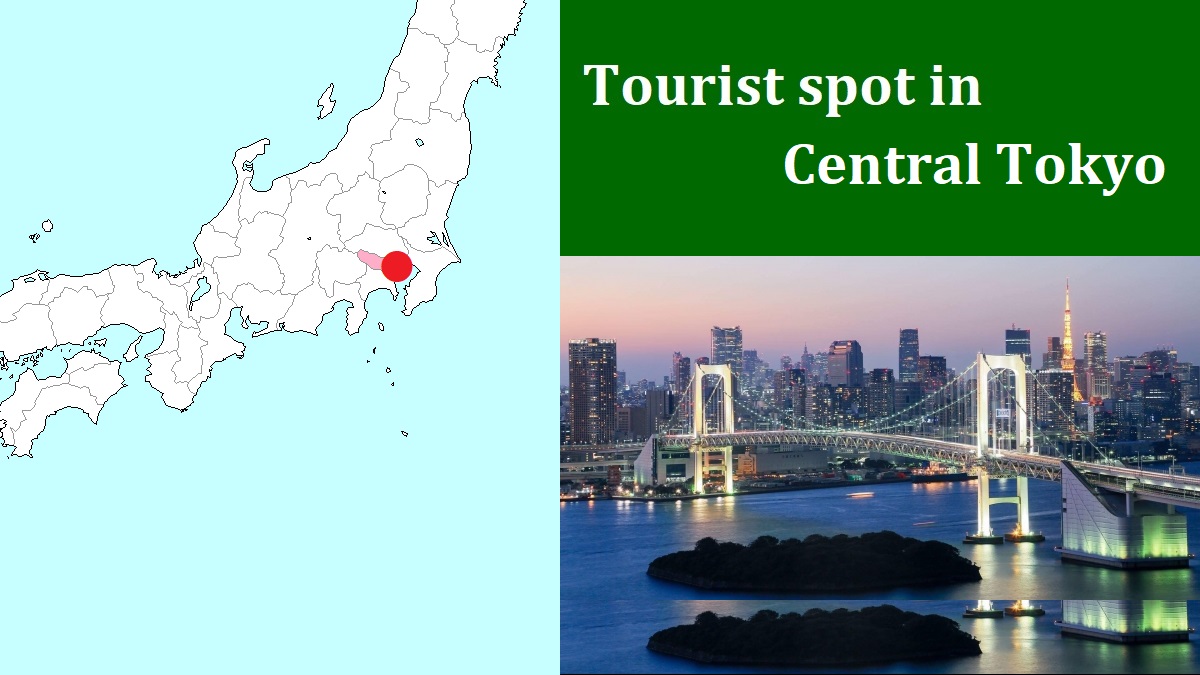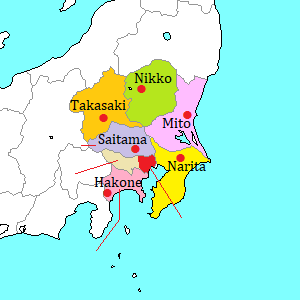Imperial Palace (Kôkyo) [皇居]
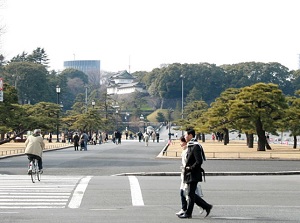
To Kokyo
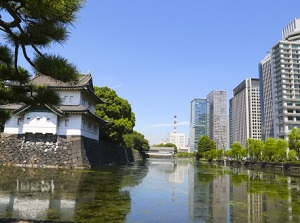
Moat of Kokyo in front of Marunouchi district
Imperial Palace ("Kôkyo" in Japanese) is the primary residence of the Emperor of Japan.
The Emperor's family are normally living here.
It is on the site of the former Edo Castle.
Edo castle was built in 1457, and it was expanded after establishment of Edo government in 1603.
The castle tower was destroyed by fire in 1657, but it wasn't rebuilt.
But the site was the widest in Japan.
After establishment of new Meiji government, this site was changed to Imperial Palace because the capital was moved from Kyoto to Tokyo and the Emperor moved to Tokyo.
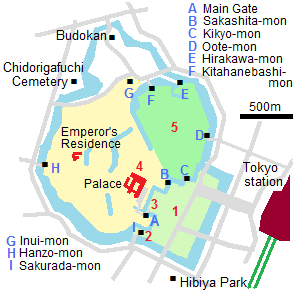
1) Kokyo-Gaien 2) Sakurada-mon gate
3) Nijubashi bridges 4) Palace
5) Kokyo East Garden
The site is surrounded by moats.
It is about 1.5 km from east to west and about 2 km from north to south.
The north part and the southeast part of the site are opened to the public as garden, park or area of cultural facilities.
Other part of the site is called "Kôkyo".
In this area, there are the Palace, the Emperor's residence and other buildings for Emperor's family.
The area is surrounded by moats and stone walls of former Edo Castle.
It has 9 gates connected with bridges across the moats.
The most parts of Kokyo are covered with forest and there are various animals and plants in the site, despite the center of Tokyo.
Basically, it is not possible for the public to enter Kokyo.
But, the guided tour for only 300 visitors is held twice a day (10:00, 13:30) from Tuesday to Saturaday.
(The following period is not held.
Sunday, Monday, Japanese national holiday, From Dec.28 to Jan.4, Afternoon tour from Jul.21 to Aug.31.)
When you want to join, you must get a numbered ticket at Kikyo-mon gate at 9:00 or 12:30.
Then, if you get the ticket, you do the entrance procedures at 9:30 or 13:00.
At that time, you must show your passport.
Every year, on January 2 and the Emperor's birthday (Feb.23), we can visit the forecourt of the palace without reservation.
We can see the Emperor's appearance on the balcony and hear the speech.
Kokyo-Gaien (皇居外苑)
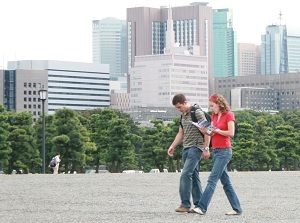
Kokyo-Gaien
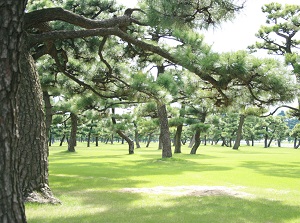
Pine trees in Kokyo-Gaien
Kokyo-Gaien is a large national garden located southeast of Kokyo.
It is about 500 meters from east to west and 800 meters from north to south.
Originally, it was a garden of Imperial family, but was opened to the public as a national park in 1949 after World War II.
The main area is covered with lawns and Japanese black pines and gravel roads.
It is very wide open space in the center of giant city.
And it is the main approach to Kokyo, so many tourists visit here.
Sakurada-mon gate (桜田門)
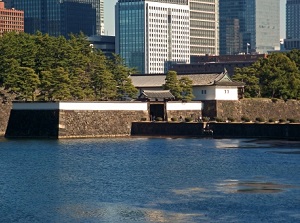
Sakurada Moat and Sakurada-mon
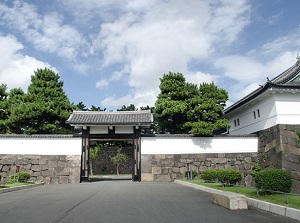
Sakurada-mon
Sakurada-mon is a gate located at the southwest corner of Kokyo-Gaien garden.
It was the south gate of Edo Castle and it was built in 1636.
In 1860, Ii Naosuke, the top assistant samurai of Shogun, was assassinated near this gate.
It is known that this case had led to the collapse of feudal Edo government of 260 years.
It is designated as a nationally important cultural property.
Nijubashi bridges (二重橋)
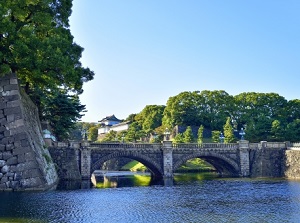
Nijubashi
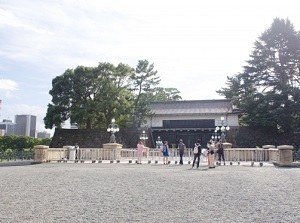
Main gate and Nijubashi
Nijubashi are the bridges in front of the main gate to Palace.
They are located at the southeast part of Kokyo.
The scenery of the stone bridge across a moat is well-known.
But, in actuality, there is another bridge about 100 meters beyond the bridge.
"Niju" means "double", so these two bridges are formally called "Nijubashi".
As above, the nearer bridge is made of stone, but another bridge is made of steel.
The visitors cross the stone bridge and enter the main gate.
They walk for 100 meters and cross the steel bridge and enter the second gate.
Then, they can reach the forecourt of the palace.
Palace (宮殿)
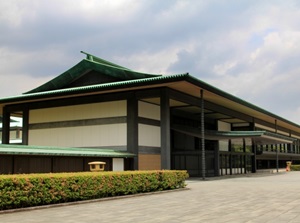
Palace
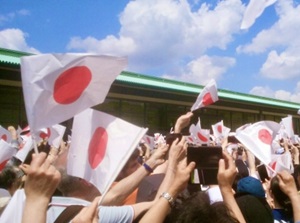
Congratulations of new year to the Emperor
Palace is the central building of Kokyo, and was built in 1968.
It has 7 wings, and there are the office of Emperor, ceremonial halls, banquet halls and other facilities in them.
It has two stories above the ground and one underground story.
The looks is modern.
In the palace, the ceremony of the Imperial family, the ceremonies relating to Japanese Government, the welcoming ceremony for important national guest, and Imperial Conferment of Decoration are held.
There is a large forecourt on the east side of the Palace.
We can see the Emperor on the balcony of Palace on Jan.2 (Congratulations of new year to the Emperor) and the Emperor's birthday.
Kokyo East Garden (皇居東御苑)
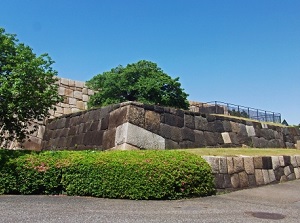
Ruin of Edo Castle
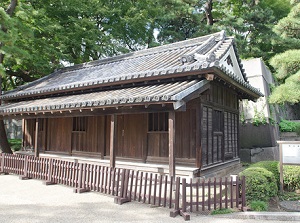
Old samurai office
Kokyo East Garden is a garden in the east part of the site of Kokyo.
It is called "Kôkyo Higashi-gyoen" in Japanese.
In this area, there were the main buildings of Edo Castle.
They had been destroyed by fire in 1657 and had not been rebuilt.
After that, some imperial buildings were built in this area.
And since 1968 it has been opened to the public.
Sometimes, it is used as a venue of court event.
This area also is surrounded by moats.
There are Japanese gardens, Edo Castle ruins, a few historical constructions, a museum and other spots.
Basically we can visit here every day except Monday and Friday.
(Additionally it is closed at some other special days.)
The entrances are Oote-mon Gate, Hirakawa-mon Gate and Kitahanebashi-mon Gate.
Admission is free, but the visitor must not act without consideration in the garden.
How to get here
To Kokyo-Gaien and Nijubashi bridges
- From Tokyo station, about 10 - 15 minutes on foot.
- Nearest stations of subway.
Nijubashi-mae (●C10 Chiyoda Line)
Hibiya (●H08 Hibiya Line, ●C09 Chiyoda Line, ●I08 Mita Line)
Sakurada-mon (●Y17 Yurakucho Line)
To Kokyo East Garden
- From Tokyo station to Oote-mon Gate, about 10 minutes on foot.
- Nearest stations of subway.
Ootemachi (●M18 Marunouchi Line, ●C11 Chiyoda Line, ●T09 Tozai Line, ●Z08 Hanzomon Line, ●I09 Mita Line)
Takebashi (●T08 Tozai Line)

